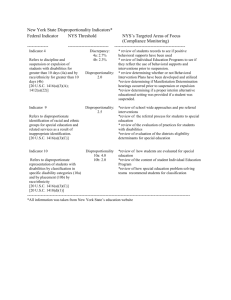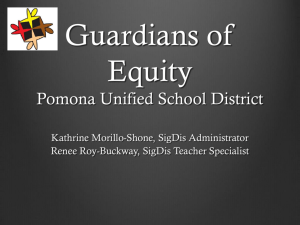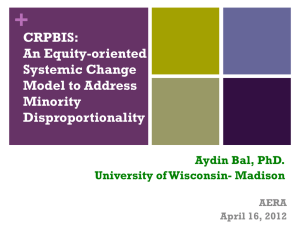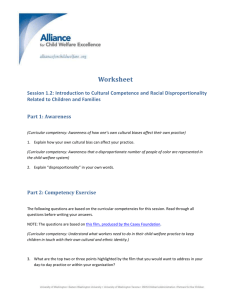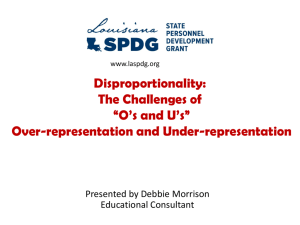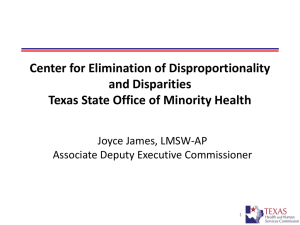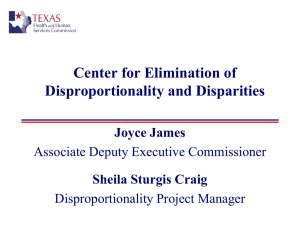Overcoming Disproportionality: One
advertisement
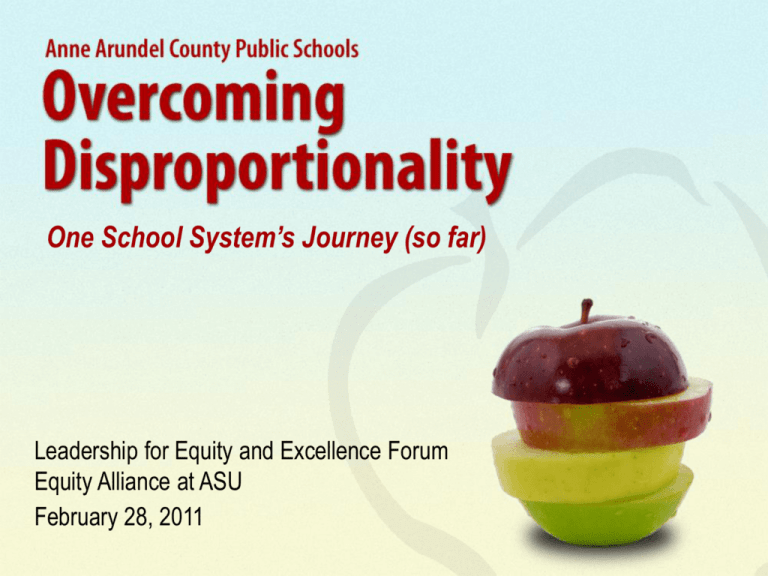
One School System’s Journey (so far) Leadership for Equity and Excellence Forum Equity Alliance at ASU February 28, 2011 Objectives • Describe the history and framework of AACPS’ approach to the issue of Disproportionality • Provide an effective protocol and systematic problem solving process that can be applied systemically or in individual schools to remediate Disproportionality • Share results and discuss factors that have been found to contribute to Disproportionality in our district • Share resources and effective strategies for addressing Disproportionality in schools The AACPS Approach History & Framework Anne Arundel County Public Schools Annapolis, MD History • Recognized as Disproportionate by Maryland State Department of Education (MSDE) – Areas of Concern Identification – in categories of Specific Learning Disability (SLD), Emotional Disturbance (ED), and Mental Retardation/ Intellectually Disabled (MR/ID) Placement Discipline – 15% EIS budget allocation requirement • Office of Civil Rights (OCR) Agreement – Establishment of Goals for the Improvement of Education and Academic Attainment among African American Students • Issue of Parity AACPS Disproportionality Workgroup • Established Spring of 2007 • Multidisciplinary Team to Collaboratively Address Disproportionality Vertically and Horizontally • Partner with the State (MSDE) for Discretionary Grant Funding and Re-examine Definition of Disproportionality • Develop, Implement, and Monitor District Level Action Plan District Level Action Plan Critical Components • Incorporation of a Collaborative Decision Making (CDM) process – RtI framework for prevention and early intervention • Review and enhanced utilization of system/school-based accountability tools: Audits/Internal Monitoring Screening Tools Special Ed Process and Forms Transfer activities • Cultural Proficiency/Stakeholder Communication District Level Action Plan Critical Components • Data Analysis & Exploration of Evidence-Based Practices for Assessment and Intervention • Provision of Equity in Resource Allocation for Intervention • Outreach to Parents & Community • System-wide implementation of a TEAM Teaching model • Value of Professional Development • Expansion of Alternative Education Options • Identification of and Outreach to Targeted Schools MSDE Disproportionality Grant • Hiring of a Disproportionality Project Facilitator • Targeted outreach to schools using the risk ratio (>2.0) – – – – 2007-08: 2008-09: 2009-10: 2010-11: 13 Target Schools 15 Target Schools (7 new & 8 returning) 15 Target Schools (6 new & 9 returning) 17 Target Schools (3 new & 14 returning/ recognizing 4 schools are between 2.00-2.04) • Provision of Materials of Instruction (MOI) & Stipend mini-grants to address inequity of resource allocation and support plan implementation • Annual Disproportionality Conference with national speakers • School Specific Training focus on Collaborative Decision Making (CDM) & Positive Behavioral Interventions & Supports (PBIS) Targeted School Outreach Remediating Disproportionality one school … one student at a time The Protocol • Initial meeting with school teams – introduce the required self-assessment tool • Follow-up meeting with school teams to review the self-assessment results & begin action planning through the CDM process • Finalize and review the school-based action plan • Implement the action plan with technical assistance and on-going progress monitoring by the Facilitator/ CDM Consultant Self-Assessment • Focuses school attention on current policies/procedures and instructional practices • Encourages raising teacher awareness of cultural issues, at the school level and within the community, as a means of addressing disproportionate numbers • Incorporates: – School Data – An Intervention Summary – Program Effectiveness Analysis – Program Summary • What’s Working? • What Requires ACTION? Problem Identification & Analysis Intervention Design & Implementation Limited Success Intervention Evaluation SUCCESS Problem Identification & Analysis Intervention Design & Implementation Intervention Evaluation • • • • Problem Areas Documented Baseline Data is Recorded Short- and Long-term Goals are Set Strengths and Resources are Highlighted • Obstacles are Prioritized & Targeted • Evidence-based Intervention Strategies are Identified Problem Identification & Analysis Intervention Design & Implementation Intervention Evaluation • Specific plan of action is developed • Accountability measures are incorporated to ensure fidelity • Progress monitoring Problem Identification & Analysis Intervention Design & Implementation Intervention Evaluation • Data is utilized to assess progress • Next steps are determined Why use CDM to address System Level Change? • Assists teams in determining the “Root Cause” of a concern while providing a framework for problem solving • Involves multiple disciplines & resources in a Professional Learning Community (PLC) to address district, cluster, and school goals • Uses data and progress monitoring to guide instructional practices • Demonstrates alignment with School Improvement Plan efforts • Provides accountability The Results Finding the Big Ideas and their Impact 4 Original “Big Ideas” in AACPS Disproportionality Identification Resources/ Interventions Professional Development Community Partnerships Big Idea #1: Identification • Need for uniformity & accuracy • Compassionate coding – Attitude that “more is better” when helping kids • Need for auditing/ accountability in initial identifications (self-audits with checklist or external audits) • What is normal? Disability defined as relative to population in school – Implementation of the WIN Project – spring 2010 • Enhanced focus on target schools making initial determination • Guidelines for re-evaluation determination process Identification Resources/ Interventions Professional Development Community Partnerships Big Idea #2: Resources/Intervention Equity of resource allocation Title I vs. AAA vs. Nothing Need for expansion of CDM & PBIS Need for approved interventions for Math & Written Language Need for support with red zone behaviors Exploration of cluster-based licensure and targeting for interventions Culturally proficient mental health services Identification Resources/ Interventions Professional Development Community Partnerships Big Idea #3: Professional Development Cultural Proficiency & Truth in Labeling CDM & PBIS Culturally Responsive Assessments Differentiated Instruction Interventions Cultural Differences in Language and Behavior Management (Is the behavior disturbed or disturbing?) Identification Resources/ Interventions Professional Development Community Partnerships Big Idea #4: Community Partnerships Mentoring opportunities Business sponsorships Outreach programs to specific communities Involvement of faith-based groups Parent education/PR on alternatives to special education Identification Resources/ Interventions Professional Development Community Partnerships Big Idea #5: Disproportionality Awareness (recognized in Spring 2009) Ongoing Progress Monitoring Continued Self-Exploration through School Improvement process Non-linear, multi-layered problem solving Courageous Conversations – “Putting the ugly on the table” Keeping the issue current & relevant Identification Disproportionality Resources/ Interventions Professional Development Awareness Community Partnerships Disproportionality Weighted Risk Ratios for Target Schools in 2007-08 6 5 4 2006 3 2007 2 1 0 ES 1 ES 2 ES 3 ES 4 ES 5 ES 6 ES 7 ES 8 ES 9 M S 10 M S 11 HS 12 HS 13 *Average change in target schools from 2006 to 2007was -0.88 Disproportionality Weighted Risk Ratios in New Target Schools for 2008-09 4 3.5 3 2.5 2007 2 2008 1.5 1 0.5 0 ES 14 ES 15 ES 16 M S 17 M S 18 M S 19 HS 20 *Average change in new target schools from 2007 to 2008 was -0.47 Disproportionality Weighted Risk Ratios in Returning Target Schools for 2008-09 6 5 4 2006 3 2007 2008 2 1 0 ES 1 ES 3 ES 5 ES 6 M S 10 M S 11 H S 12 H S 13 *Average change in returning target schools from 2006 to 2008 was -1.24 In the Spring of 2009, AACPS was recognized as no longer Significantly Disproportionate for Special Education Identification by MSDE . The journey continues! The Journey MUST Continue! 3.5 3 2.5 2 Baseline After 1 Year After 2 Years After 3 Years 1.5 1 0.5 0 2 0 0 7 - 0 8 N e w S c hool s 2 0 0 8 - 0 9 N e w S c hool s 2 0 0 9 - 10 N e w S c h o o l s *Average 1-Year change for all schools is -20% from baseline 2-Year change is -24% from baseline 3-Year change is -10% (impacted by decreasing Special Ed enrollment numbers) Identified Resources Recognized on the Journey Sharing Strategies and Research Resource Guide • Summarizes key components of AACPS process • Includes effective strategies identified in action plans • Incorporates a Companion CD with links to important documents, research, and websites • Online version available at http://www.aacps.org/ocr/cdrom.pdf Questions? Mary Tillar – mtillar@aacps.org Eric Levine – ealconsulting@comcast.net Kristen Mayle – kristenmayle@yahoo.com

